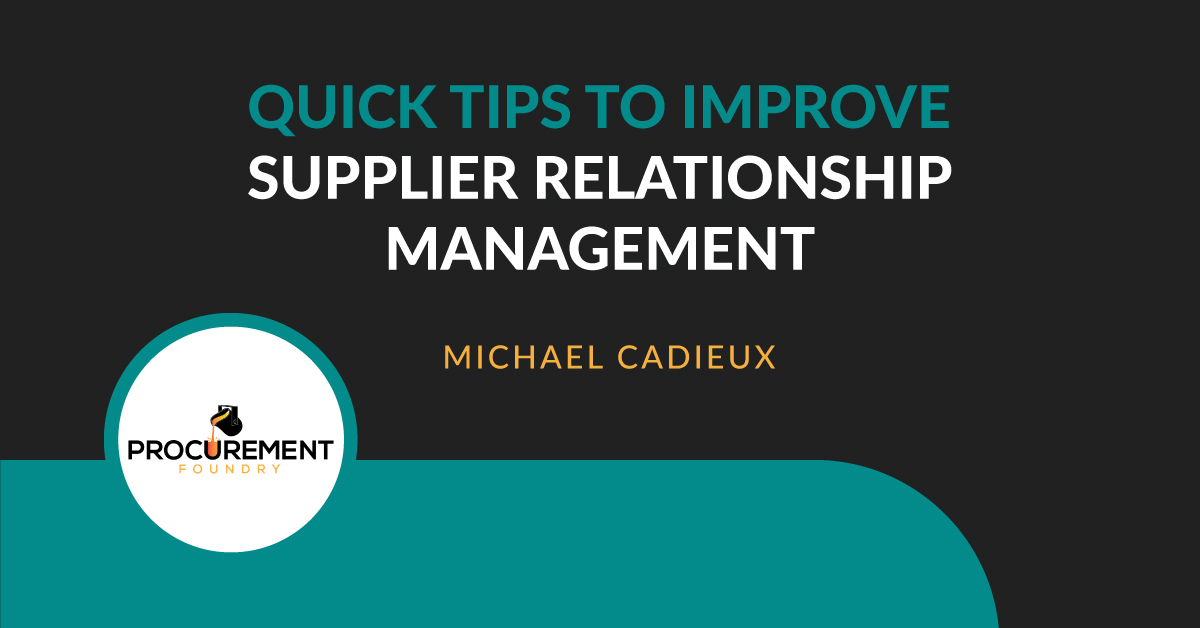Maximizing Savings Opportunities and Procurement's Strategic Value for CPOs
Saving money is not always about pinching pennies: advanced and data-driven insights enable you to identify real cost-saving opportunities, negotiate...

Supplier relationship management—also known as SRM—is a common topic inside of the Foundry. While SRM was an essential element of operations before COVID-19, having a steady and agile supply chain setup took the spotlight in 2020.
When supply chain madness started to shake things up, organizations began scrambling to put out fires everywhere (shortages, transportation issues, and many more logistical woes). Something had to give. Their supplier relationship management had to improve—and evolve—with the dramatic shift in the times.
Now, here we are in 2022, and everyone has gotten on board. Everywhere you go, people are talking about the necessity of establishing—and maintaining—superior supplier relationship management within their organizations.
When we speak of SRM, we describe the process of integrating the optimal technology, processes, resources, and tools needed to keep your organization in step with your suppliers, thus creating stronger and more loyal, long-lasting relationships.
Here are a few quick tips you can use to insert some magic into your supplier relationship management.
One way to improve supplier relationship management is by keeping things simple. A significant first step is simplifying the RFP process.
A request for proposal (RFP) is a document that an organization, often a government agency or large enterprise, posts to elicit a response—a formal bid—from potential vendors for a desired solution. As the RFP is traditionally the first contact with a potential supplier, it should be seamless.
How? For starters, make sure there is a function allowing potential suppliers to ask any questions and stay in direct communication with you throughout the entire process.
Likewise, make it easy for vendors to answer and reply to your queries, which will keep you from getting incomplete or late responses, or worse, experiencing a complete stall in the process.
The RFP process only works when the channels of communication are wide open, easy to navigate, and there is a mutual investment of time and energy in responding from both sides to move the process closer to a “Let’s Make a Deal” conclusion. After all, when it all comes down to a winning RFP, collaboration is ultimately the secret key to success.
Note: Suppliers complain constantly that responding to RFPs is way too complicated. Remove the complication and get better results.
Being upfront, honest, and fair on your RFPs will save both you and bidders a wealth of wasted time and headache. RFPs should not be unwinnable or favor a competitor; that’s not only a waste of time but poses a considerable amount of frustration.
And speaking of frustration, avoid this by opting not to ask questions that are unfair or difficult for vendors to answer.
Another way that you can improve your vendor management relations is by sending a post-RFP debrief as part of your RFP process. By doing so, you can help potential vendors understand how to do better in the future when vying for your business.
Still, on the RFP topic, an essential step for improvement is to be sure and remove any questions that are irrelevant to the final decision. Why muddy the waters with requests for miscellaneous—and extraneous—information that won’t even have an impact at the end of the day?
Again, the biggest complaint with RFPs is the time it takes to complete one and how much of that time is unnecessary. It comes down to respect—value your suppliers’ time.
Along that same line of thought, show vendors respect by not sending RFPs to suppliers you aren’t considering. No one wants to have their time wasted, vendors included.
We live in a time where technology is evolving at a breakneck pace. With that evolution comes a wealth of innovative and unique tools that we can utilize to streamline and simplify—thus improving—our supplier relationship management.
You would be amazed at how the right technology can improve your team’s internal process and provide a better supplier experience before business is awarded. Technology can offer faster and more accurate proposal analysis, anonymized proposal scoring to reduce bias, consistent evaluation through automatic scoring, an auditable and transparent process, and much more.
It can even allow you to conduct side-by-side proposal comparisons for easier decision making, as well as enable a framework for faster vendor communication as you respond to queries, fix omissions and errors, or organize and catalog supplier responses.
For those seeking a technology solution right now, there are SaaS providers available. Some of our vendor partners have channels inside of the Foundry and are available to chat at any time. Join the Foundry to get access to them.
If you’re looking for information or discussion on improving your operations—supplier relationship management included—join the Foundry. Our members help each other reach their full potential, starting with incorporating the right processes that will get you where you want to be.

Saving money is not always about pinching pennies: advanced and data-driven insights enable you to identify real cost-saving opportunities, negotiate...

The topic of our recent roundtable discussion with a dozen Procurement Foundry community members—exploring potential flaws in procurement incentive...

Every 30 days or so, I get the same alert on my phone—“Your electricity bill is available for viewing.” I take a quick look, make sure nothing seems...